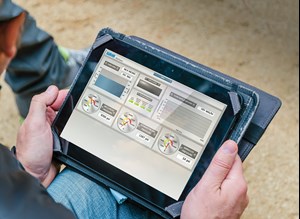Executive Viewpoint
Controls, sensors, smart phones, tablets and analytics are becoming as ubiquitous as drill bits and wellheads in today’s oil field. As an industry, we must continue to push the envelope of innovation, to keep shale plays competitive with other parts of the world.

The strategy’s foundation lies in attracting the right talent and fostering a culture of continuous innovation. The good news is that our industry is already traveling at light speed when it comes to technological advancements, which is out of the ordinary for the upstream sector.
Twenty years or so ago, it would have been unheard of to consider that a driller would replace standing on a rig floor with his hand on a brake and throttle, in favor of sitting in a control room that resembles something from NASA’s Mission Control. We are just now tapping the surface of where these modernizations and digitization of the oil field will take us.
So, how did we get here? It is counterintuitive to believe that we owe oilfield advancements to an economic slowdown. However, the recent downturn allowed companies to innovate on behalf of their customers, so they could hit the ground running when the recovery began.
Thanks to new technologies, companies are offering new, fit-for-purpose applications that can be tailored to any condition or basin. For example, simplified frac iron systems significantly reduce the amount of iron on site, from the frac stack to the zipper manifold. Think of the simplification that this brings to the job site: less potential leaks to chase, fewer connections, and a decrease in non-productive time, to name a few. This “less is more” approach pays off in terms of savings and safety.
Beyond simplified frac iron systems, highly automated technology is removing the guesswork for managed-pressure drilling and flow-back operations. This technology now provides real-time data and automated controls to enhance safety, reduce environmental impact, and enable customers to make more-informed decisions. No more measuring flames to determine gas volumes.
These systems provide customers with a control panel that has the ability to receive and record information from sensors placed on pressure control equipment. This information can be communicated through a cloud-based customer portal. It collects data for a single piece of equipment or multiple products, depending on need. An entire system can be used, or customers now have the ability to rent control panels and sensors, and retrofit them to their own equipment.
The people angle. But this industry transformation is not just about products. It’s also about people. The shift we are seeing in the oil and gas industry to embrace cloud-based solutions and advanced engineering technologies requires broader thinking to implement new approaches from different disciplines, to create efficiencies and safety in the field.
The industry continues to lower the cost of lifting shale oil and gas out of the ground, thanks to the advancement of technology and digitization of the oil field. Some of us still remember looking for shale on an electric log and strategizing on how to avoid it, because we could not extract resources from it. Now, we use a variety of technologies to pinpoint exactly where the shale is, drill into it horizontally, and complete the well safely and efficiently.
The technology we use to do that is the result of the people that we hire, coupled with the culture of innovation that we foster. That is why Weir appointed Geetha Dabir to the position of chief technology officer. An electrical and software engineer, whose career has been spent in Internet of Things (IoT) leadership roles with Intel Corp. and Cisco Systems Inc., Geetha has moved from Silicon Valley to the heart of the shale industry in Texas. Why?
This appointment signals an important change in direction of the company’s innovation philosophy. It is also a strong indicator of a cultural shift that prioritizes digitization, and the type of talent required to support that initiative. The desired skill sets for new hires are expanding, from petroleum and mechanical engineers to electrical and electronic engineers—or ideally combinations of both skill sets.
Our industry has much to offer from a technology point of view. And we have to start early with programs in high school that educate students on the opportunities for innovation in oil and gas. In addition, rotational programs for college graduates are proving to be effective for companies to attract and develop talent.
It used to be that paperwork was actually done on paper. Those days have been replaced with tablets, smart phones, and similar applications (see photo on this page). It is certain that the adoption and evolution of technology is energizing the industry and transforming its workforce.
Global shifts accelerated the need for the industry to become more efficient while minimizing environmental impact. It’s an exciting time to be in oil and gas, and help shape our evolving industry with highly engineered technologies. ![]()
- Coiled tubing drilling’s role in the energy transition (March 2024)
- The reserves replacement dilemma: Can intelligent digital technologies fill the supply gap? (March 2024)
- What's new in production (February 2024)
- Digital tool kit enhances real-time decision-making to improve drilling efficiency and performance (February 2024)
- E&P outside the U.S. maintains a disciplined pace (February 2024)
- U.S. operators reduce activity as crude prices plunge (February 2024)
- Applying ultra-deep LWD resistivity technology successfully in a SAGD operation (May 2019)
- Adoption of wireless intelligent completions advances (May 2019)
- Majors double down as takeaway crunch eases (April 2019)
- What’s new in well logging and formation evaluation (April 2019)
- Qualification of a 20,000-psi subsea BOP: A collaborative approach (February 2019)
- ConocoPhillips’ Greg Leveille sees rapid trajectory of technical advancement continuing (February 2019)


